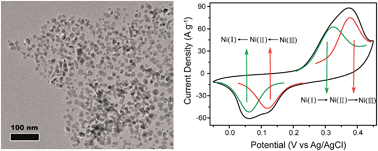A novel Ni3N/graphene nanocomposite as supercapacitor electrode material with high capacitance and energy density†
Abstract
A novel Ni3N/graphene nanocomposite of small Ni3N nanoparticles anchoring on the reduced graphene oxide nanosheets has been successfully synthesized. Due to the quite small size of Ni3N nanocrystals, the surface for faradic redox reaction of pseudocapacitive materials dramatically increases. The main issue of the volume change obstructing the pseudo-supercapacitor performance is concurrently resolved by the tight attachment of Ni3N nanoparticles with flexible texture. Importantly, the two-step oxidation/reduction reaction between Ni(I) and Ni(III) endows this nanocomposite with large capacitance by providing more faradic charge. The kind of electrode material behaves excellently both in three-electrode and asymmetric supercapacitors. The biggest specific capacitance reaches to 2087.5 F g−1 (at 1 A g−1), and its asymmetric supercapacitor cell with ethylene glycol modified RGO as negative electrode has a high energy density (50.5 W h kg−1 at 800 W kg−1). The cell capacitance retention exceeds 80% after 5000 cycles at different high current densities, showing its promising prospects for high-energy supercapacitors.


 Please wait while we load your content...
Please wait while we load your content...